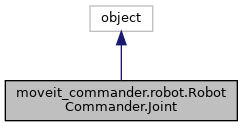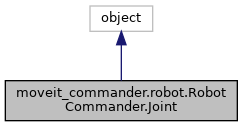Definition at line 44 of file robot.py.
◆ __init__()
| def moveit_commander.robot.RobotCommander.Joint.__init__ |
( |
|
self, |
|
|
|
robot, |
|
|
|
name |
|
) |
| |
◆ bounds()
| def moveit_commander.robot.RobotCommander.Joint.bounds |
( |
|
self | ) |
|
@return: Either a single list of min and max joint limits, or
a set of those lists, depending on the number of variables
available in this joint.
Definition at line 61 of file robot.py.
◆ max_bound()
| def moveit_commander.robot.RobotCommander.Joint.max_bound |
( |
|
self | ) |
|
@return: Either a single max joint limit value, or
a set of max values, depending on the number of variables
available in this joint.
Definition at line 85 of file robot.py.
◆ min_bound()
| def moveit_commander.robot.RobotCommander.Joint.min_bound |
( |
|
self | ) |
|
@return: Either a single min joint limit value, or
a set of min values, depending on the number of variables
available in this joint.
Definition at line 73 of file robot.py.
◆ move()
| def moveit_commander.robot.RobotCommander.Joint.move |
( |
|
self, |
|
|
|
position, |
|
|
|
wait = True |
|
) |
| |
@param position [float]: List of joint angles to achieve.
@param wait bool: If false, the commands gets operated asynchronously.
Definition at line 112 of file robot.py.
◆ name()
| def moveit_commander.robot.RobotCommander.Joint.name |
( |
|
self | ) |
|
◆ value()
| def moveit_commander.robot.RobotCommander.Joint.value |
( |
|
self | ) |
|
@rtype float
(Editor's comment by @130s) I doubt there's a case where this method goes into
"else" block, because get_current_joint_values always return a single list.
cf. getCurrentJointValues https://github.com/ros-planning/moveit_ros/blob/8e819dda2b19462b8d0c5aacc69706c8a9d8d883/planning_interface/robot_interface/src/wrap_python_robot_interface.cpp#L176
Definition at line 97 of file robot.py.
◆ variable_count()
| def moveit_commander.robot.RobotCommander.Joint.variable_count |
( |
|
self | ) |
|
@return number of the list that _Joint__get_joint_limits
methods returns.
@see: http://docs.ros.org/en/latest/api/moveit_core/html/cpp/classmoveit_1_1core_1_1JointModel.html#details
for more about variable.
Definition at line 52 of file robot.py.
The documentation for this class was generated from the following file:
- moveit_commander/src/moveit_commander/robot.py







